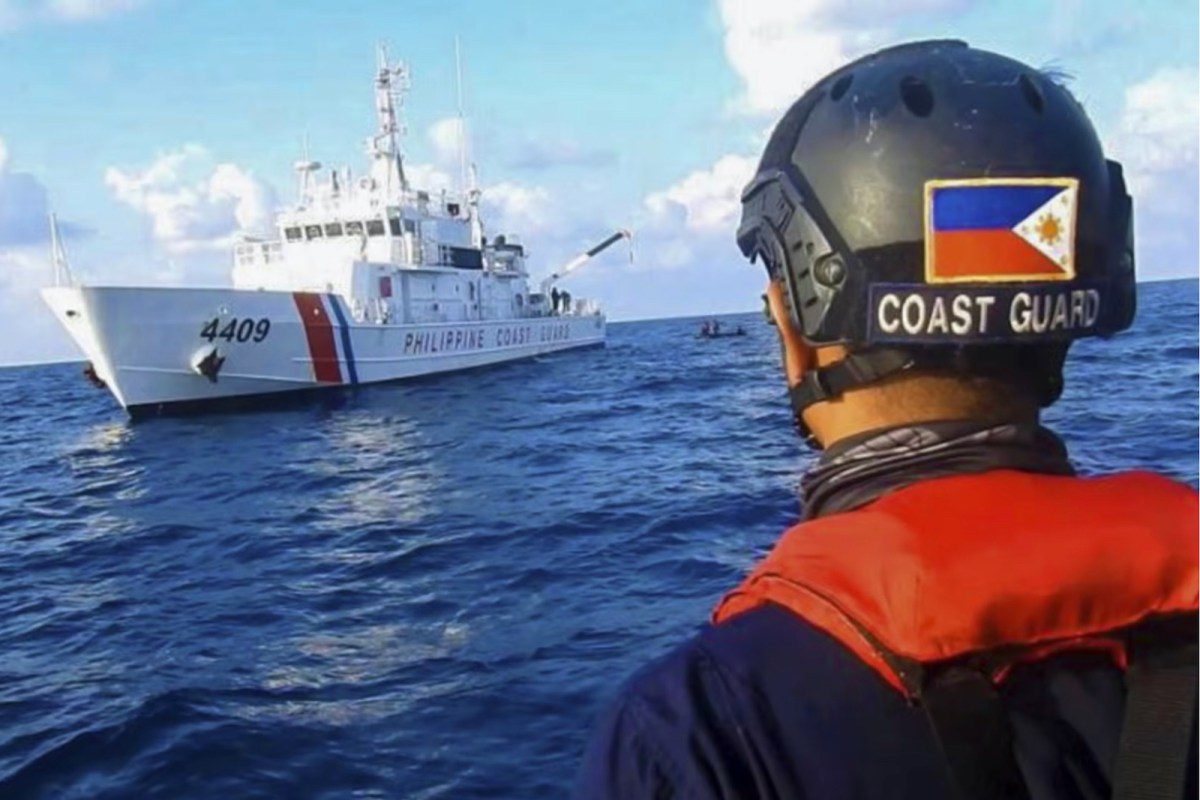Global Courant 2023-05-17 16:23:33
MANILA – “They are not only there for navigation safety for ships, but they also serve as a sovereign marker. As you can see, we have placed the Philippine flag there and are strengthening our presence. declared Philippine Coast Guard (PCG) Vice Admiral Joseph Coyme, citing five buoys his troops recently placed over the hotly contested Spratly Islands in the South China Sea.
“Absolutely, (we’re sure of it) because the buoy we put down carries the flag of the Philippines,” the Philippine maritime official added when asked if rivals like China would appreciate the significance of Manila’s latest act of maritime assertiveness. amid strengthening ties with its traditional ally the United States.
The PCG also announced plans to place six more buoys in the sea by the end of the year. At the same time, the PCG recently delivered basic supplies, including food and books, to Filipino residents permanently stationed on Thitu Island, the largest naturally formed land feature in the area that China has historically blocked.
The move by Philippine authorities came just weeks after several PCG cutters almost collided with a Chinese warship in the South China Sea amid growing bilateral tensions in recent months.
It also came not long after the Philippines signed new defense guidelines with the US Pentagon, which has pledged to help its treaty ally deal more effectively with threats in the area, including operations in the “grey zone” by China.
Buoyed by growing defense cooperation with its superpower ally, Manila is taking on China with growing confidence and determination, effectively marking the end of former President Rodrigo Duterte’s fruitless strategic flirtation with Beijing during his six-year term in office.
In the past year, the PCG has transformed into a primary tool for asserting Philippine sovereign claims in the area against China. This marks a dramatic transformation for the maritime agency, which just a few years earlier had been a hub of friendly ties with Beijing under a Duterte appointee.
In 2019, the Beijing-friendly Philippine president appointed a new commander of the PCG, Vice Admiral Joel Garcia, a confident and outspoken official who openly advocated warmer ties with the Asian superpower.
Then-Chief of the Philippine Coast Guard, Joel Garcia, in a file photo waving flags. Photo: Philippine government
Before his appointment as PCG chief, Garcia had done just that endorsed joint exploration agreements with China in energy-rich areas claimed by the Philippines as “within the limits of our Constitution. And I would say the Philippines would be better off having that partnership.
Moreover, he downplayed the threat posed by the growing number of Chinese ships encircling Philippine-held islands in the South China Sea. He persistently opposed critics of Duterte’s Beijing-friendly policies, describing China as a “important partner”, also in prohibiting maritime drug trafficking, rather than a threat to Philippine sovereign claims and interests.
At one point even Garcia publicly warned Philippine sailors from defying China’s de facto control of the Philippines-claimed Scarborough Shoal. Ironically, it was precisely a crisis around the same shoal that helped transform PCG’s role and kickstart the modernization of the maritime agency for the 21st century.
For decades, the PCG was a largely underappreciated and under-armed agency that primarily played second fiddle to the Philippine Navy in protecting the maritime interests of the Southeast Asian nation.
But the months-long naval standoff between Manila and Beijing during the 2012 Scarborough Shoal crisiswhen a Philippine Navy vessel was challenged by multiple Chinese Coast Guard vessels shortly after capturing a Chinese fisherman, it marked a turning point for the PCG.
Intent on avoiding a similar crisis, the Benigno Aquino III administration began investing in the PCG along with key allies, especially the United States and Japan. Not long after the Scarborough Shoal engagement, Japan donated multipurpose patrol craft and the US assisted in setting up the National Coast Watch Center (NCWC).
In the following years also the US Coast Guard expanded his joint exercises with the PCG, which began to benefit from increasing government investment. In 2019, the PCG announced plans recruit up to 4,000 officers to bolster its 36,000-strong workforce.
Then Secretary of Transportation Arthur Tugade, who oversaw the PCG, emphasized the role of the Maritime Agency as the primary state agency “responsible for the maritime activities related to UNCLOS and on the West Philippine Sea (South China Sea).”
However, the departure of Duterte and his appointees gives new impetus to the PCG’s mission to resist China’s assertiveness in Philippine waters. Under President Ferdinand Marcos Jr. the Philippines has redoubled its traditional alliances and taken an increasingly tough stance on Beijing in the South China Sea.
Philippine President Ferdinand Marcos Jr. was the first foreign head of state to be honored on May 3, 2023 at the Pentagon under the administration of US President Joseph Biden. Photo: Philippine Government
Earlier this month, Marcos Jr. the Pentagon, where he oversaw the signing of a six-page document on “bilateral defense guidelines”, which aims to facilitate closer cooperation in the field of security. Under the new guidelines, the Pentagon has vowed to help Manila jointly fight so-calledgray zone” threats, including by Chinese maritime militias.
“Recognizing that threats can arise across domains – including land, sea, air, space and cyberspace – and take the form of asymmetric, hybrid and irregular warfare and gray zone tactics, the guidelines outline a way forward to build interoperability in both conventional and non-conventional domains”, Recognized by the Pentagon in the new defense directive with Manila.
Accordingly, the two allies plan, among other things, to strengthen “combined deterrence and capacity to resist coercion” and “to coordinate closely in the modernization of the defense of the Philippines,” according to a US Department of Defense. announcement to the new directive.
Backed by its superpower ally, the Philippine Navy is also in on the act. Philippine National Security Advisor and former Army Chief Eduardo Ano signaled an even more assertive stance from the PCG and the Philippine Naval Forces in the coming months.
“I sincerely hope that the PCG continues to deploy buoys to other maritime features in the (South China Sea) throughout the remainder of your term,” Ano said during a recent conversation with Philippine Coast Guard Commander Admiral Artemio Abu.
The Philippine Navy has shown its growing support for its PCG counterparts as it seeks to redouble its commitment to countering China’s creeping presence in the disputed territories.
“Today, the maritime environment has become complex. Nations have resorted to using white ships, I refer (to) coastguard ships, to prosecute their territorial claims. That blurs the distinction between the Navy and the Coast Guard,” said Vice Admiral Toribio Adaci Jr. of the Philippine Navy recently.
“We need to focus on external defense operations because… the challenge is really in our territorial waters,” he added, signaling growing cooperation with the PCG to address shared concerns in the area.
Meanwhile, Philippine lawmakers are also redoubled their support for the PCG amid tightening security cooperation with the US and festering disputes with China.
Representative Leody Tarriela (Oriental Mindoro) introduced a new bill on May 10, known as the “PCG Modernization Act,” which aims to boost the PCG with new “state-of-the-art airborne and floating assets and communication systems. The bill notes that the maritime agency’s capabilities are still “insufficient to carry out its mandates,” given Beijing’s rapid naval expansion in recent years.
“(Current maritime) challenges require the PCG to operate with the highest level of efficiency and effectiveness to protect the country’s maritime interests and territorial integrity,” Tarriela said in a joint press release with the Coast Guard.
A Philippine naval officer stands guard during the arrival of the US missile destroyer USS Chung Hoon for US and Philippine joint naval military exercises in an archive photo. Photo: AFP/Noel Celis/Getty Images
Meanwhile, in a sign of shifting political sands, Senator Christopher Go, a key aide to former President Duterte, served a separate PCG modernization proposal in the upper house to bolster the proposal of his congressional counterparts.
Should the new bill become law, the PCG will go through a four-part development program for 12 years. Philippine maritime authorities, basking in growing support from all sides, have warned China of “serious consequences” if it attempts to remove recently installed buoys across the South China Sea.
“If we have evidence that they deliberately disabled our installed buoys, which we believe is legitimate, there will be dire consequences,” Vice Admiral Coyme, the chief of the Coast Guard’s Maritime Security Command, warned without elaborating.
Follow Richard Javad Heydarian on Twitter @Richeydarian
Similar:
Loading…








